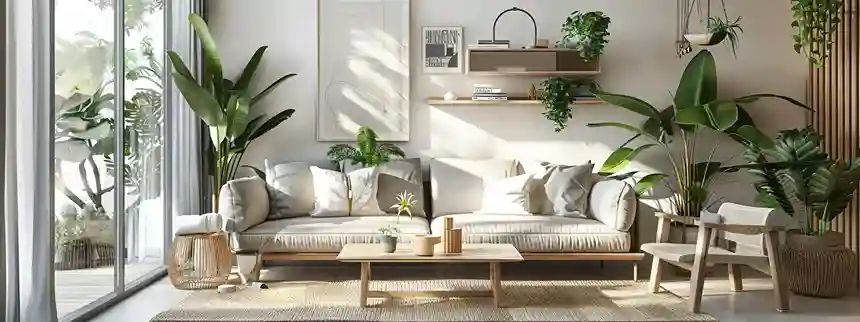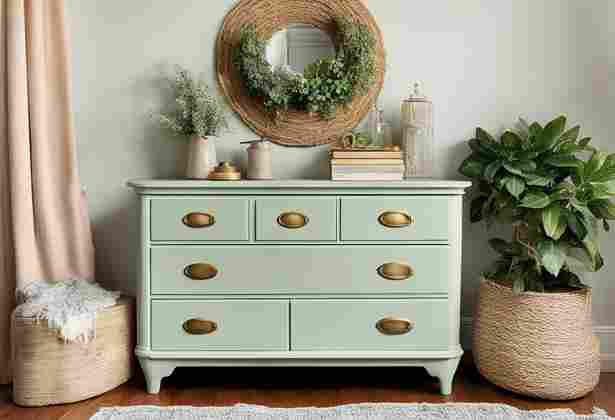Biophilic Design Ideas to Refresh Your Home Now
In today’s fast-paced world, our homes have become more than just a place to live—they’re our sanctuary. And one of the most powerful ways to create a calm, inviting space is through Biophilic Design. It’s not just a trend—it’s a lifestyle that brings nature indoors to help us feel more grounded, peaceful, and connected.
So, what is Biophilic Design exactly? Simply put, it’s the art of designing spaces that connect us to the natural world. That means more natural light, greenery, earthy colors, and materials like wood, stone, and linen—all thoughtfully arranged to enhance well-being.
In this post, we’ll walk through room-by-room ideas to refresh your home using Biophilic Design—perfect for modern, minimalist spaces. Whether you’re updating your living room, kitchen, bedroom, or even your home office, you’ll find easy tips to bring a breath of fresh air into every corner of your home.
What Is Biophilic Design and Why It Matters
At its core, Biophilic Design is all about bringing the outside in. It’s a design approach that uses natural elements—like plants, light, water, wood, and earthy textures—to make indoor spaces feel more alive, balanced, and connected to the natural world.
The idea is simple: humans feel better when we’re surrounded by nature. But in our modern lives, we often spend most of our time indoors. Biophilic Design helps bridge that gap by weaving nature into our everyday spaces—without needing a backyard or a forest view.
Why does it matter? Because it works. Studies show that Biophilic spaces can reduce stress, improve air quality, support better sleep, and create a sense of calm. Even a few small changes—like adding greenery or using natural materials—can make a big difference in how we feel at home.
This design style pairs beautifully with modern minimalist homes. Clean lines, open space, and simple color palettes create the perfect canvas for soft, organic touches. The result? A home that feels fresh, restful, and effortlessly stylish.
Key Principles of Biophilic Design in Modern Homes
One of the reasons Biophilic Design works so beautifully in modern, minimalist homes is because both styles value simplicity, balance, and a sense of calm. By blending natural elements into clean, open spaces, you create a home that feels both stylish and nurturing. Here are the key principles to focus on:
☀️ Natural Light and Open Spaces
Letting in more daylight is a core part of Biophilic Design. Large windows, glass doors, and open layouts help blur the line between inside and out. Natural light not only brightens your space—it also boosts your mood, productivity, and sleep.
🌿 Organic Materials and Textures
Think wood, stone, clay, linen, and rattan. These materials bring warmth, texture, and authenticity to otherwise sleek, minimalist interiors. Biophilic Design invites you to trade shiny plastics for earthy finishes that feel good to the touch.
🎨 Earth-Toned Color Palettes
Biophilic Design favors calming colors inspired by nature—soft greens, sandy beiges, warm browns, muted blues, and gentle terracotta. These hues promote a peaceful energy and work well with the neutral tones often found in minimalist homes.
🪴 Indoor Greenery and Living Elements
Plants are one of the most powerful (and affordable!) tools in Biophilic Design. Whether it’s a hanging pothos, a tall fiddle leaf fig, or a small herb garden, living greenery brings life, movement, and freshness into your space—no clutter required.
🌀 Natural Shapes and Soft Curves
Modern design loves clean lines, but Biophilic Design softens those edges with rounded furniture, arched doorways, and nature-inspired decor. Curves mimic the organic shapes we find in the wild and help make a home feel more welcoming and relaxed.
Room-by-Room Refresh Ideas
🛋️ Living Room: Create a Calm, Nature-Inspired Retreat
The living room is where most of us relax, gather, and unwind—which makes it the perfect place to introduce Biophilic Design. A few thoughtful updates can transform it from a standard sitting area into a calming, nature-connected space.
Start with natural light. Swap out heavy curtains or dark blinds for sheer fabrics that let sunlight flow in freely. Bright, open spaces set the tone for a healthier, more uplifting atmosphere.
Next, bring in plants. A couple of well-placed potted plants—on a shelf, next to the sofa, or hanging near the window—can instantly freshen the room. If you want a bold, modern look, try a vertical garden wall as a living art piece.
Choose organic materials for your furniture and décor. Wood, stone, jute, or rattan add natural texture and warmth. Even small pieces—like a wooden coffee table or woven basket—can make a big impact.
Finally, lean into an earth-toned color palette. Shades like soft olive, beige, clay, or warm gray help create a grounded, minimalist aesthetic that feels both cozy and elevated.
With just these simple touches, your living room can embody the heart of Biophilic Design—welcoming, peaceful, and full of life.
🍽️ Kitchen: A Fresh, Functional Space with Natural Energy
The kitchen is the heart of the home—and it’s a great place to bring in Biophilic Design elements that are both beautiful and practical.
Start by adding greenery in simple ways. Open shelves are perfect for displaying small potted herbs like basil, rosemary, or mint. They not only brighten up the space but also add fresh scents and flavor to your cooking.
Choose natural materials for everyday items. Wooden utensils, bamboo cutting boards, stoneware mugs, and ceramic bowls all add an earthy, grounded feel to your kitchen. These small swaps help your space feel more connected to nature, even in its busiest moments.
If possible, maximize airflow and natural light. Open windows while you cook, use lightweight shades, or consider a skylight if you’re renovating. The more light and fresh air you bring in, the more vibrant and energizing your kitchen will feel.
In Biophilic Design, the kitchen isn’t just about function—it’s a space to feel alive, inspired, and connected to the rhythms of nature.
🛏️ Bedroom: Turn Your Sleep Space into a Nature-Inspired Retreat
Your bedroom should be the most restful room in your home—and Biophilic Design helps create a sleep-friendly space that feels calm, cozy, and connected to nature.
Start with your color palette. Soft earth tones like sage green, warm beige, dusty rose, and gentle terracotta can make your room feel grounded and soothing. These colors mimic the natural world and are proven to promote relaxation.
Next, look at your bedding and textiles. Choose breathable, natural fabrics like cotton, linen, or bamboo. They not only feel better against your skin but also help regulate temperature and airflow for a better night’s sleep.
Add a few air-purifying plants to your bedroom—snake plants, peace lilies, or pothos are great low-maintenance options. Even one plant on a nightstand or windowsill brings life and calm to the room.
Don’t forget natural touches in your decor. Think woven baskets, wooden side tables, or dried flower arrangements. These small elements support a minimalist style while staying true to the spirit of Biophilic Design.
The result is a bedroom that doesn’t just look peaceful—it actually helps you rest, recharge, and wake up feeling more refreshed.
🚿 Bathroom: Create a Spa-Like Escape with Biophilic Design
The bathroom may be one of the smallest rooms in the house, but it offers a big opportunity to bring in calming, nature-inspired elements through Biophilic Design.
Start with plants that thrive in humidity—like ferns, pothos, or peace lilies. Place a small potted plant near the sink, hang one from the ceiling, or use wall-mounted planters to add life without taking up counter space. Even a single plant can soften the space and create a spa-like feel.
Next, switch out synthetic items for natural materials. Use wooden or bamboo trays, stone soap dishes, and woven baskets to store towels or toiletries. These textures add warmth and a grounded feel to a typically cold, functional space.
Consider your lighting as well. If you have a window, keep it unobstructed to let in as much natural light as possible. For bathrooms without windows, try warm, soft lighting that mimics daylight to create a more relaxing atmosphere.
In Biophilic Design, the bathroom isn’t just for utility—it’s a place to slow down and care for yourself, surrounded by elements that make you feel calm, clean, and connected to nature.
🏢 Biophilic Design for Small or Rental Spaces
Just because you’re short on space—or renting—doesn’t mean you can’t enjoy the benefits of Biophilic Design. In fact, smaller spaces often make it easier to create that cozy, nature-connected feeling with just a few smart updates.
Start with peel-and-stick materials. You can mimic wood paneling, stone backsplashes, or natural textures using removable wall treatments that are renter-friendly and low-commitment. These bring warmth and organic style without permanent changes.
Add hanging planters or window boxes to introduce greenery without using up precious floor space. Even a few trailing vines near a window can liven up the room and instantly boost your mood.
Don’t forget about scent—a powerful, often-overlooked part of Biophilic Design. Essential oil diffusers or soy-based candles in calming, earthy scents like cedarwood, lavender, or eucalyptus can make your space feel grounded and refreshed.
Finally, use mirrors strategically to reflect greenery, natural textures, and sunlight. This not only makes a room feel larger but also spreads those nature-inspired elements throughout the space.
With just a few affordable updates, even the smallest apartment can become a peaceful, Biophilic retreat that brings the outdoors in—no major renovations required.
⚠️ Common Mistakes to Avoid
While Biophilic Design is all about inviting nature into your home, there’s a fine line between thoughtfully styled and accidentally chaotic. Here are a few common missteps to watch out for—especially in minimalist homes where balance is everything:
❌ Overcrowding with Too Many Plants
It’s tempting to fill every surface with greenery, but more isn’t always better. Too many plants can clutter a space and overwhelm the clean, airy feeling that Biophilic Design aims to create. Instead, choose a few well-placed plants that add life without crowding the room.
❌ Using Fake Plants with No Life or Texture
Artificial plants may seem like an easy fix, but they often lack the vitality that true Biophilic Design celebrates. If you can’t commit to live plants, try dried flowers, real branches, or preserved moss walls for natural texture without the maintenance.
❌ Ignoring Airflow and Natural Light
Opening a window, letting sunlight pour in, or allowing fresh air to move through your home is a key part of feeling connected to nature. Don’t block windows with heavy drapes or forget about ventilation—fresh air is part of the experience.
❌ Adding “Green” Without Natural Materials
Biophilic Design isn’t just about throwing in a few green accents. It’s about incorporating real, organic materials—wood, stone, linen, clay—that ground your space in nature. A room with plastic plants and synthetic decor misses the heart of the concept.
Avoiding these common mistakes helps you create a home that truly captures the spirit of Biophilic Design—peaceful, natural, and beautifully intentional.
🛠️ Simple Weekend Projects to Try
Bringing Biophilic Design into your home doesn’t have to mean a full renovation. In fact, a weekend is all you need to make a noticeable shift toward a more natural, calming space. These small, satisfying projects are budget-friendly and beginner-approved:
🌿 Build a DIY Plant Shelf or Wall Garden
Dedicate a small section of a wall to floating shelves or a pegboard and fill it with potted plants, hanging vines, or small herb planters. It’s functional, beautiful, and gives you a vertical “green zone” that draws the eye upward.
🪑 Rearrange Furniture to Maximize Natural Light
Sometimes, the best transformation comes from simply moving things around. Shift your seating area closer to windows, clear objects blocking sunlight, and create open walkways that make the room feel lighter and more breathable.
🧘 Create a Nature Nook
Choose a corner to turn into your personal retreat—add a cozy chair, a soft throw, a floor plant, and maybe a small side table. Place it near a window or somewhere quiet and use it as your reading, journaling, or tea spot.
🧺 Swap Out Synthetic Decor for Natural Textures
Spend an afternoon replacing plastic or synthetic home items with pieces made of wood, clay, linen, or rattan. Think baskets, lampshades, planters, or even a new mirror frame—small swaps that make a big visual difference.
These quick Biophilic Design updates don’t just refresh your home—they also reset your mindset. You’ll feel the difference almost immediately.
🌿 Final Thoughts
Biophilic Design isn’t just about decorating—it’s about transforming your home into a calming, nourishing space that brings you closer to nature every day. Whether you’re adding more plants, embracing natural light, or choosing organic textures, each small change adds up to something powerful.
In modern, minimalist homes, this design style feels right at home. Clean lines meet soft materials. Open spaces welcome fresh air and sunlight. And every room becomes more than just functional—it becomes a peaceful retreat.
You don’t need a huge budget or a complete remodel to bring Biophilic Design to life. Just start small. One plant, one window, one natural element at a time.
🌱 What’s your favorite way to bring nature into your home?
Drop a comment below—we’d love to hear your ideas and see how you’re using Biophilic Design to refresh your space!
Frequently Asked Questions
Your top questions about Biophilic Design—answered.
1. What is Biophilic Design in home decor?
Biophilic Design is a style that brings nature indoors using natural light, plants, earthy colors, and organic materials. It helps create a peaceful, balanced home that feels more connected to the natural world.
2. How can I start using Biophilic Design on a budget?
Start small—add a few indoor plants, open up your space to more natural light, and swap plastic decor for wooden or woven pieces. You don’t need a full makeover to feel the impact.
3. Is Biophilic Design only for large or open homes?
Not at all! Biophilic Design works beautifully in small apartments and rentals. Hanging plants, mirrors, and removable natural textures can make a big difference without needing extra square footage.
4. What types of plants are best for Biophilic Design?
Choose easy-care plants like pothos, snake plants, peace lilies, or ferns. These thrive indoors and bring a fresh, lively look without requiring much maintenance.
5. Can I use Biophilic Design if I don’t have much natural light?
Yes. While natural light is ideal, you can use warm, soft lighting, reflective surfaces, and nature-inspired textures to create a similar feel. Focus on creating a sense of openness and flow.
6. Is Biophilic Design the same as eco-friendly design?
Biophilic Design is about how a space feels—visually and emotionally connected to nature. Eco-friendly design focuses more on sustainability and using green materials. The two often go hand-in-hand.
7. How does Biophilic Design affect well-being?
It can reduce stress, improve air quality, boost creativity, and promote a greater sense of calm. Being surrounded by natural elements has been shown to support mental and emotional health.
8. Can Biophilic Design fit into a minimalist home?
Absolutely. In fact, minimalist homes are a perfect match for Biophilic Design. Clean lines and uncluttered spaces pair well with organic textures, natural materials, and soft earthy colors.

Michael Reyes is a versatile blogger with a primary focus on farming and sustainable living. Growing up close to nature, he developed a deep interest in agriculture and enjoys sharing practical tips on backyard farming, modern cultivation techniques, and eco-friendly practices. While farming remains his specialty, Michael also writes on a wide range of topics, from lifestyle and travel to everyday inspiration, making his work relatable to a broad audience.
Outside of writing, Michael enjoys spending time outdoors, experimenting with new farming methods, and exploring different cultures through food and travel. His approachable voice and well-researched insights make his blogs both informative and engaging.


